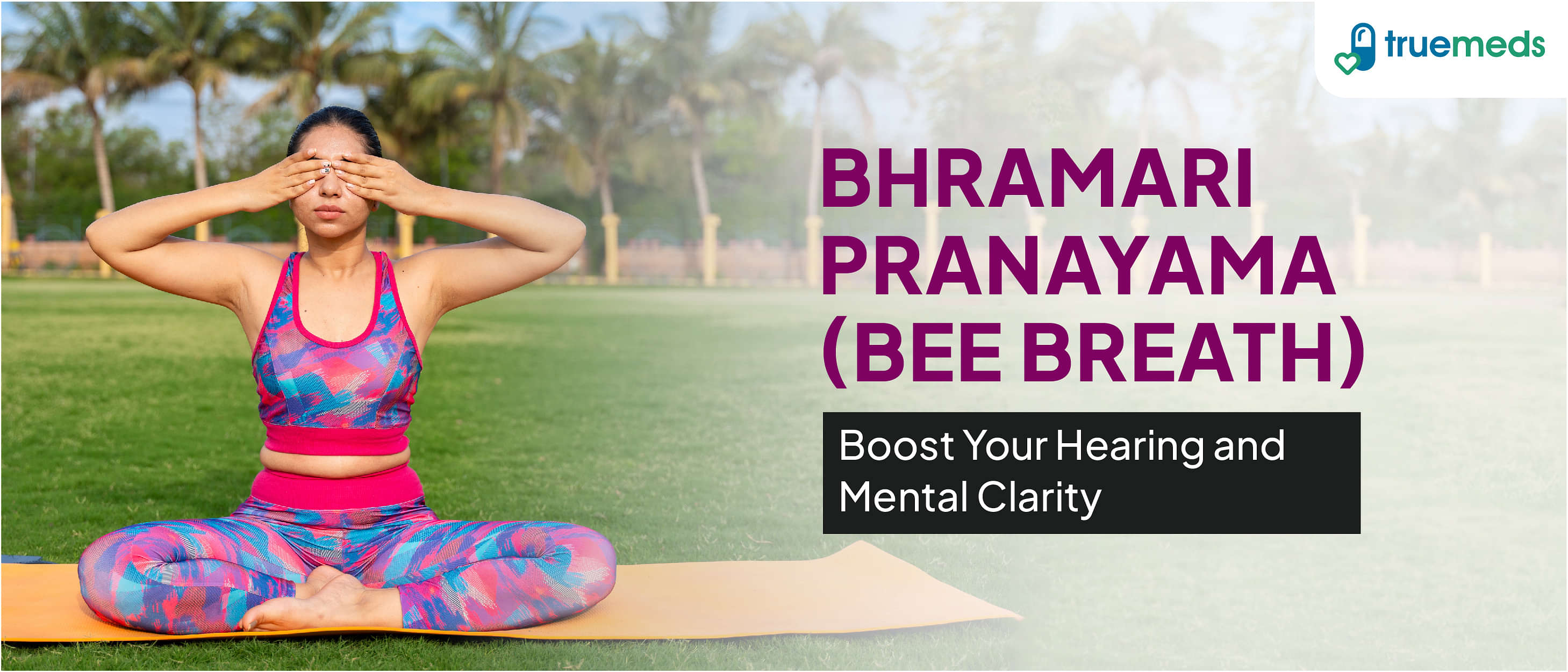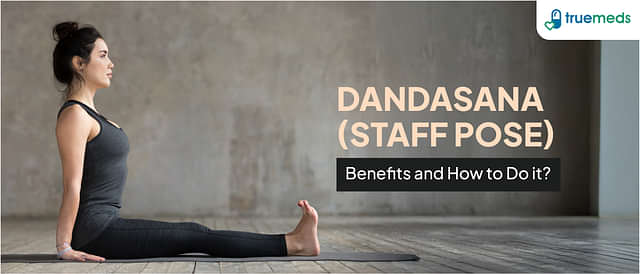Bhramari Pranayama (Bee Breath): Benefits and Steps
Last updated on : 01 Dec, 2025
Read time : 10 min
What is Bhramari Pranayama?
Bhramari Pranayama, literally meaning “bee breath,” is a tranquil and powerful yogic breathing technique that involves producing a continuous, low-pitched humming sound during exhalation, similar to the buzzing of a bee. This practice is widely recognized as a simple yet effective method for reducing stress and promoting a sense of calm [1]. It is often utilized to help manage restlessness, stress, and anger, and may be a beneficial addition to a routine for those seeking better sleep quality [1].
To practice, sit comfortably in a meditative posture, close your eyes, and traditionally place your thumbs on the tragus (the small cartilaginous flap at the ear opening) and your fingers over your eyes, forming Shanmukhi Mudra. This humming sound supports concentration and creates a balance of the mind and body. Bhramari Pranayama nourishes the inner self and is perfect for beginners.
Let’s explore the benefits, variations, precautions, and practical tips.
What are the Potential Benefits of Bhramari Pranayama?
Bhramari Pranayama is a gentle yet potent practice that focuses on internal vibrations. Studies suggest its positive impact on the nervous and cardiovascular systems [2].
Below are some potential benefits associated with the practice:
- Supports Sleep Quality: Incorporating Bhramari Pranayama into your evening routine may facilitate a more restful and deep sleep [3]. By calming the nervous system, it can effectively reduce the symptoms associated with mild insomnia, promoting peaceful sleep [3].
- May Improve Auditory Perception: The continuous, controlled humming sound produced during this pranayama stimulates the ears and is suggested to help enhance hearing sensation and auditory perception [1].
- Contributes to Cardiopulmonary Health: Research indicates that Bhramari Pranayama can lead to a reduction in heart rate and may enhance the cardiovascular response to exercise, suggesting a calming effect on the heart [2].
- May Ease Nasal Congestion: The controlled, vibrational breathing in Bhramari Pranayama may help in temporary relief from nasal congestion. Anecdotal evidence suggests the vibrations can help clear airways, which may be beneficial if you have a mild allergy or a cold.
- Helps Soothe Throat Irritation: The gentle humming sound produced during Bhramari Pranayama may have a soothing effect on the throat lining, potentially alleviating mild irritation.
- Calms the Mind and Reduces Stress: This yoga pose acts as a stress-buster, releasing tension. The calming effects of this pranayama contribute to a more composed and balanced state of mind [3].
- Supports Concentration and Memory: The calming influence of Bhramari Pranayama on the nervous system helps to quiet mental chatter, which, in turn, may help enhance focus and memory by creating an environment conducive to improved concentration [3].
- Promotes Holistic Well-being and Relaxation: This practice also helps promote inner peace and helps resolve emotional disturbances by cultivating inward focus and a sense of meditative stillness.
Bhramari Pranayama Steps: How to Perform Bee Breath
Incorporating Bhramari Pranayama into your routine can promote relaxation, focus, and mental clarity. Here’s your guide to practice Bhramari Pranayama according to Hathayoga:
- Preparation: Sit comfortably in a meditative pose, such as Siddhasana, Sukhasana, or Padmasana. Keep your spine straight, pay attention to your natural breath, and relax your body.
- Mudra Application (Optional): Close your eyes, relax your facial muscles, and slightly tilt your neck upward. The most common technique involves placing your index fingers over your eyes, middle fingers next to your nose, ring fingers above your lips, and little fingers below your lips. Use your thumbs to gently press the tragus (ear cartilage) to close the ear canal (Shanmukhi Mudra). Focus on breathing gently through both nostrils.
- Inhale: Take a slow, deep, and steady breath through both nostrils, filling the lungs completely.
- Exhale & Hum: Keeping the ears gently sealed, slowly exhale while making a deep, uniform, and soft humming sound, similar to the letter ‘M’ sound. The sound should be generated from the back of the throat and sustained for the entire length of the exhalation.
- Concentration: Concentrate on the sound and the resulting vibrations in your head, particularly around the brow center (Ajna Chakra).
- Repetition: When exhalation is complete, lower the hands to the knees (or keep the Mudra) and breathe in slowly.
- Continue to practice in the same way, performing 5 to 10 rounds, or as guided by your instructor.
- Completion: When completed, keep your eyes closed for a few moments and sit in silence, listening for any subtle sounds or echoes of the humming within.
- Bhramari Pranayama is often done at the end of a yoga session. Afterwards, it is recommended to relax your body completely in Savasana to restore the balance between your body and mind.
Variations in the Practice of Bhramari Pranayama
Experimenting with variations can deepen your practice and internal awareness:
- Tonal Variations: You can produce the humming bee sound only during exhalation for focused breath control. Experiment with different humming tones such as “mmmm,” “nnnnn,” or a nasal “ng” to explore subtle vibratory effects.
- Gender-Specific Tones: Traditionally, inhale while creating a deep, resonant sound resembling that of a male bee and exhale with a gentler, high-pitched hum similar to a female bee.
- Breath Retention (Kumbhaka): Include antar kumbhaka (breath retention after inhalation) or bahya kumbhaka (breath retention after exhalation) to intensify internal awareness. These should only be attempted under the guidance of an experienced instructor.
- Advanced Practice with Bandhas: Combine bahya kumbhaka (retention after exhalation) along with mahabandha (combination of all three bandhas—Mula, Uddiyana, and Jalandhara) for advanced practice.
- Modified Ear Sealing: Modify the ear sealing by using the index and middle fingers to gently press the outer ear cartilage toward the earlobe, reducing external sound input.
- Integrated Mudra and Bandha: Combine Shanmukhi Mudra with Mula Bandha (root lock) to enhance pranic engagement and meditative stillness.
What are the Important Precautions for Bhramari Pranayama?
As with any pranayama, safety and mindful practice are paramount. If you have any health concerns, consult your doctor and a certified yoga instructor before beginning.
Here are a few precautions to consider:
- Migraine and Headache Concerns: If you have a history of severe migraines or a current headache, it is often best to avoid the practice or perform it with extreme gentleness (no pressure on the ears) and with your eyes open. The internal pressure generated by the humming can sometimes exacerbate these conditions.
- Heart Problems: If you have a heart condition or high blood pressure, practice Bhramari Pranayama for a shorter duration and ensure the humming sound is gentle and soft, without any excessive strain or forceful exhalation, as this can temporarily increase blood pressure.
- Ear Infections/Severe Congestion: Individuals with an active or severe ear infection, or significant nasal/sinus congestion, should temporarily avoid this practice. The pressure changes can be uncomfortable or harmful.
- Stomach Condition: It is traditionally recommended to practice pranayama on an empty stomach or at least 3-4 hours after a heavy meal to ensure comfortable breathing and avoid digestive discomfort.
Tips for Practising Bhramari Pranayama
- Establish Natural Breath: Pay attention to your natural breath before starting. Once ready, focus on breathing gently through both nostrils. This sets the foundation for the humming breath.
- Controlled Sound: Create the buzzing sound, “Hmmmm,” slowly and in control. Avoid putting too much pressure on your chest and lungs. Let the sound be rhythmic and pleasant for a soothing practice.
- Embrace Stillness: After each round, close your eyes and sit in silence, paying attention to the echoes of the humming sound within. Embrace the stillness to experience the full calming effects of Bhramari Pranayama.
- Preparation Poses: Prepare yourself for Bhramari Pranayama with gentle stretching poses such as Sukhasana (Easy Pose), Padmasana (Lotus Pose) or Siddhasana (Adepts Pose), Marjarasana (Cat-Cow Pose), Bhujangasana (Cobra Pose), and Ujjayi Pranayama (Victorious Breath). These poses will help you centre yourself before starting pranayama.
- Counterposes for Balance: Practice counterposes after Bhramari Pranayama. These may include Balasana (Child’s Pose), Shavasana (Corpse Pose), Nadi Shodhana (Alternate Nostril Breathing), or Sheetali Pranayama (Cooling Breath). These help to harmonise the body and mind after a focused pranayama practice.
- Optimal Timing: For optimal results, try practising Bhramari Pranayama for longer periods (5-10 minutes). Include this yoga posture in your routine after performing a sequence of asanas (physical poses).
Takeaway
Bhramari Pranayama is a valuable and gentle pranayama for holistic well-being. Evidence suggests its beneficial role in stress reduction, promoting a sense of relaxation, and supporting better sleep quality [3]. The practice may also help temporarily ease mild nasal or throat irritation and support concentration [1]. Always approach the practice with caution, respecting traditional recommendations to practice on an empty stomach and to avoid it during severe conditions like active ear infections or migraines. If you have any serious health issues, it is essential to seek guidance from a doctor before attempting this pose.
Frequently Asked Questions (FAQs)
How long should you perform Bhramari yoga?
You should perform Bhramari Pranayama for 5 to 10 minutes daily to experience its calming and stress-relieving benefits.
Why is Bhramari Pranayama called Bee Breath?
Bhramari Pranayama is called Bee Breath because it involves producing a characteristic humming sound similar to the buzzing of a bee during exhalation.
Is there an age limit for practising Bhramari Pranayama?
There is no specific age limitation for practising Bhramari Pranayama; it can be performed by individuals of all ages, provided they can sit comfortably and follow the instructions. Always consult a yoga practitioner before beginning any new pranayama techniques.
What happens when you do Bhramari Pranayama?
When you practice Bhramari Pranayama, the humming sound helps to calm the nervous system, which in turn reduces mental stress, improves concentration, and promotes a deep sense of calm and inner peace.
Is Bhramari good for the brain?
Yes, Bhramari Pranayama is beneficial for the brain as the calming effect on the nervous system helps to reduce mental stress, enhances focus, and promotes a sense of calm and relaxation (1).
Who should avoid Bhramari?
Individuals with severe ear infections, those who have high blood pressure or a heart condition (must practice very gently), or those with significant nasal congestion should approach this practice with caution or avoid it until the conditions are resolved.
References
[1] Kuppusamy, M., Kamaldeen, D., Pitani, R., Amaldas, J., & Shanmugam, P. (2017). Effects of Bhramari Pranayama on health – A systematic review. Journal of Traditional and Complementary Medicine, 9(3), 195-201. https://doi.org/10.1016/j.jtcme.2017.02.003
[2] Trivedi, G. Y., & Saboo, B. (2014). Bhramari Pranayama – A simple lifestyle intervention to reduce heart rate, enhance the cardiovascular response to exercise. Indian Journal of Physiology and Pharmacology, 58(3), 232–237. https://www.ijpp.com/exploring-the-health-benefits-of-bhramari-pranayama-humming-bee-breathing-a-comprehensive-literature-review/
[3] Niroula, B. (2023, September). The effects of Bhramari Pranayama on stress reduction, cognitive function, and sleep quality. Research Gate. Retrieved October 29, 2025, from https://www.researchgate.net/publication/374236061_The_Effects_of_Bhramari_Pranayama_on_Stress_Reduction_Cognitive_Function_and_Sleep_Quality
Disclaimer
Our healthcare experts have carefully reviewed and compiled the information presented here to ensure accuracy and trustworthiness. It is important to note that this information serves as a general overview of the topic and is for informational purposes only. It is not intended to diagnose, prevent, or cure any health problem. This page does not establish a doctor-patient relationship, nor does it replace the advice or consultation of a registered medical practitioner. We recommend seeking guidance from your registered medical practitioner for any questions or concerns regarding your medical condition.
Popular Articles
Recommended Articles
Recent Articles
Company
About UsHealth ArticleHealth StoriesHealth LibraryDiseases & Health ConditionsAyurvedaUnderstanding Generic MedicinesAll MedicinesAll BrandsNeed HelpFAQSecuritySubscribe
Registered Office Address
Grievance Officer
Download Truemeds
Contact Us
Our customer representative team is available 7 days a week from 9 am - 9 pm.
v4.11.0
2026 - Truemeds | All rights reserved. Our content is for informational purposes only. See additional information.
Our Payment Partners














































